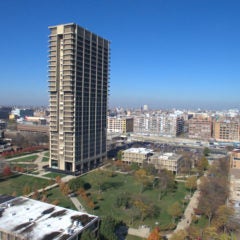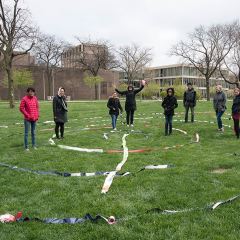Geothermal Energy

Regardless of the temperature outside, people always feel comfortable inside Grant, Lincoln, and Douglas Halls. However, the energy required to heat and cool these UIC buildings generated some of the highest levels of greenhouse gas emissions on campus. Then a revolutionary project cut the emissions in half.
title Heading link
These buildings now have a a constant indoor temperature of 73 degrees F all year long
Geothermal power Heading link

There is a geothermal system below the field just east of University Hall that hosts a vertical labyrinth of pipes that heat and cool the air in Grant, Lincoln, and Douglass Halls. The structure sits 500 feet underground, which is more than five times as deep as University Hall is tall.

The buildings use a closed-loop system with sensors, heat pumps and air exchangers, taking advantage of the relatively constant earth temperatures in the well field to maintain a comfortable indoor air environment year-round.
In the winter, the closed loop pipes bring up the ‘heat of the earth.’ An electric compressor collects the warmth, and the building’s Heating, Ventilation, and Air Conditioning (HVAC) system distributes the warm air. In the summer, the process is reversed, and the pipes draw away the indoor heat and carry it back underground.

Actions like taking public transportation and using energy-efficient appliances are examples of individual efforts that benefit the environment on a global scale. Members of the UIC community can learn about UIC’s green culture and by embracing it, can employ the university’s sustainability strategies in their post-campus lives.

A geothermal maze
Inspired by the idea that the pipes underground look similar to a maze, the geothermal well field was active above ground for a day with UIC volunteers. The field displayed several strips of vinyl made from used outdoor banners. In the middle of the field, volunteers laid the banner strips in a pattern on the grass to create a circular maze.
| UIC Museum & Exhibition Studies, 2016